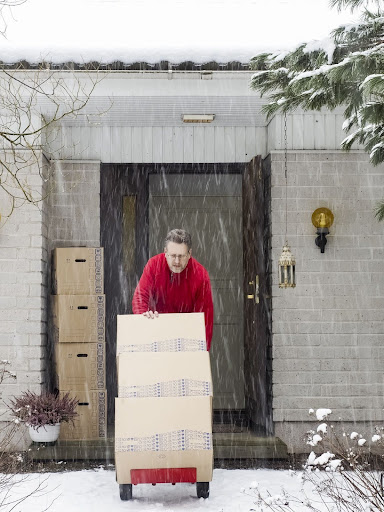Wintertime moves come with a host of unique challenges. Along with all the tasks and stresses of relocating your family, you also have to deal with unpredictable and potentially hazardous weather. When temperatures plummet, there are a handful of items that can be damaged or ruined.
Which Items Need Special Protection During My Winter Move?
Cold weather (especially below-freezing temperatures) can be especially detrimental on the following items:
- Appliances
- Electronic Devices
- Musical Instruments
- Glass Containers
- Wood Furniture
Now, let’s plunge into how to keep these items safe:
How to Protect Appliances When You Move in the Winter
When moving in the winter, protecting your large appliances is crucial, especially those involving water, like washing machines and refrigerators. Here’s how to prepare them for a chilly relocation:
Washing Machines
- Drain Completely: Ensure all water is drained from the hoses and internal components to prevent freezing.
- Clean and Dry: After draining, clean the interior and let it dry fully to avoid mold.
- Secure Moving Parts: Use transit bolts to stabilize the drum during the move.
- Insulate for Transport: Wrap the machine in moving blankets to protect against cold temperatures.
Refrigerators
- Defrost and Drain: Unplug and defrost your refrigerator, draining any water from the drip pan and disconnecting water lines.
- Thorough Cleaning: Clean the interior and leave it open to dry, preventing mold and odors.
- Stabilize Internal Components: Remove or secure shelves and drawers.
- Wrap for Insulation: Use moving blankets for added protection against the cold.
Additional Tips
- Start preparations at least a week in advance.
- Consider a climate-controlled moving truck.
- Seek professional movers for handling and advice.
- Allow appliances to acclimate before reinstalling at the new location.
Moving Electronic Devices in the Winter
Electronic devices are extremely vulnerable to temperature fluctuations and moisture. Here’s how to keep them safe:
Understanding the Risks
- Temperature Sensitivity: Electronics like smartphones and laptops have optimal temperature ranges. Exposure to extreme cold can cause components to become brittle, leading to malfunctions or delayed responses.
- Condensation Dangers: Moving from a cold environment into a warm one can cause condensation on internal components, potentially leading to corrosion, rust and short circuits.
- Battery Issues: Batteries in devices like laptops and smartphones are particularly susceptible to cold, draining faster and potentially sustaining long-term damage.
Packing and Transporting Electronics
- Backup Data: Always back up important data before moving your electronics.
- Optimal Packing: Use padded foam and waterproof, lockable plastic totes for packing. Avoid cardboard boxes as they offer little protection against moisture.
- Temperature-Controlled Environments: Store electronics in heated areas while packing. Avoid placing them near heating sources or in overly hot rooms.
- Personal Transport: For valuable or sensitive electronics, consider transporting them in your personal heated vehicle, using insulated bags to provide additional protection.
- Moving Van Considerations: In a moving van, ensure that electronics are well-insulated and kept away from extreme cold. If immediate unpacking isn’t possible, consider a climate-controlled storage unit.
Acclimatizing Electronics
- Room Temperature Adjustment: Allow electronics to gradually acclimate to room temperature for about 24 hours before plugging them in or turning them on.
- Avoid Rapid Temperature Changes: Sudden shifts from cold to hot can increase the risk of condensation, so transition your devices slowly.
Additional Tips
- Waterproof Containers: Utilize waterproof totes for extra protection against snow and rain.
- Individual Care: Pay special attention to sensitive items like laptops and gaming systems.
- Professional Advice: Consult your device manuals or manufacturers for specific temperature guidelines and handling advice.
Keeping Musical Instruments Safe in the Cold
 The challenges of moving in cold weather are particularly acute for musical instruments, especially wood-based ones like woodwinds and string instruments. Here are tips for safeguarding them:
The challenges of moving in cold weather are particularly acute for musical instruments, especially wood-based ones like woodwinds and string instruments. Here are tips for safeguarding them:
Understanding the Risks
- Humidity and Temperature Impact: Wood instruments are highly susceptible to damage from low humidity and cold temperatures, risking cracks and warping.
- Hard Cases Aren’t Enough: Even with high-quality hard cases, instruments can be vulnerable if exposed to extremely low temperatures or incorrect humidity levels (ideally between 40% and 55%).
Protective Measures
- Maintain Humidity: Use humidifiers in instrument cases to keep humidity levels within the safe range.
- Manage Temperature: Keep instruments in a climate-controlled environment during transport to avoid cold damage.
- Secure Packing: Wrap instruments in bubble wrap or specialized bags for insulation, ensuring a tight fit in their cases.
Special Care for Different Instruments
- Woodwinds: Disassemble and individually wrap parts, focusing on joints and keys.
- String Instruments: Loosen the strings to reduce tension due to temperature changes.
- Pianos: Opt for professional movers who specialize in pianos, considering their unique handling requirements.
Post-Move Care
- Gradual Warming: Let instruments adjust to room temperature slowly before unpacking.
- Inspection and Tuning: Check for damage and have a professional assess and tune the instrument if necessary.
Additional Recommendations
- Professional Movers: For valuable or antique instruments, hiring specialist movers is advisable.
- Personal Vehicle Transportation: If feasible, transport sensitive instruments in your personal vehicle for better environmental control.
Protecting Sealed Glass Containers During a Cold Move
Don’t let the chilly weather damage your wine collections and keepsake glassware. Here are some tips to protect sealed glass containers from the cold:
Understanding the Risk
- Expansion and Breakage: Liquids in sealed glass containers can expand when frozen, risking the shattering of the glass.
- Vulnerability to Cold: Glass containers are particularly at risk in cold temperatures, especially if they contain liquids.
Safe Transportation
- Avoid Cold Storage: Do not store sealed glass containers in areas that will be exposed to freezing temperatures.
- Climate Control: Consider transporting these items in the cab of the moving truck or in your personal vehicle where temperatures are more easily regulated.
- Proper Insulation: Wrap glass containers in bubble wrap or use specialized packing materials to insulate them from the cold.
Additional Recommendations
- Personal Care: For valuable or sentimental glass items, personal transport provides the best control over the environment.
- Checking Storage Spaces: Ensure that any storage space used temporarily during the move is not prone to extreme temperature drops.
How to Keep Your Wooden Furnishings Damage-Free
Moving with wooden furniture such as bed frames, dressers, tables and other items can be risky in the winter. Here’s how to keep these items damage-free:
 Understanding the Risk
Understanding the Risk
- Cold Weather Damage: Wooden furniture is susceptible to damage in cold conditions, potentially leading to warping or cracking.
Pre-Move Preparation
- Waxing: Apply wax to your wooden furniture one to two weeks before moving. This adds a layer of protection and helps retain moisture in the wood.
Packing and Transporting
- Proper Wrapping: Use industrial plastic wrap or moving blankets to wrap each furniture piece before taking it outside. This helps insulate them from the cold.
- Avoid Direct Contact: Do not pack or store wooden furnishings directly next to each other. This can create pockets of cold air and moisture, exacerbating the risk of damage.
Additional Recommendations
- Climate Control: If possible, transport wooden furnishings in a climate-controlled environment.
- Careful Loading: Ensure that these items are securely loaded into the moving vehicle to minimize movement and potential damage.
- Room Temperature Acclimatization: Once at the new location, allow the furniture to slowly acclimate to room temperature before unwrapping.
Avoid a Moving Meltdown this Winter with Bekins Van Lines
 Professional moving assistance can always provide peace of mind, but it’s especially helpful during the colder months. At Bekins, we offer a plethora of specialty moving and packing services and valuation for protection for any accidents that may happen.
Professional moving assistance can always provide peace of mind, but it’s especially helpful during the colder months. At Bekins, we offer a plethora of specialty moving and packing services and valuation for protection for any accidents that may happen.
Our expert movers are equipped to carefully relocate virtually anything from pianos to collectables and everything in between. Ready to make your winter move? If you’re moving out of state, start by getting a moving estimate. If you’re moving locally, find your local agent.


